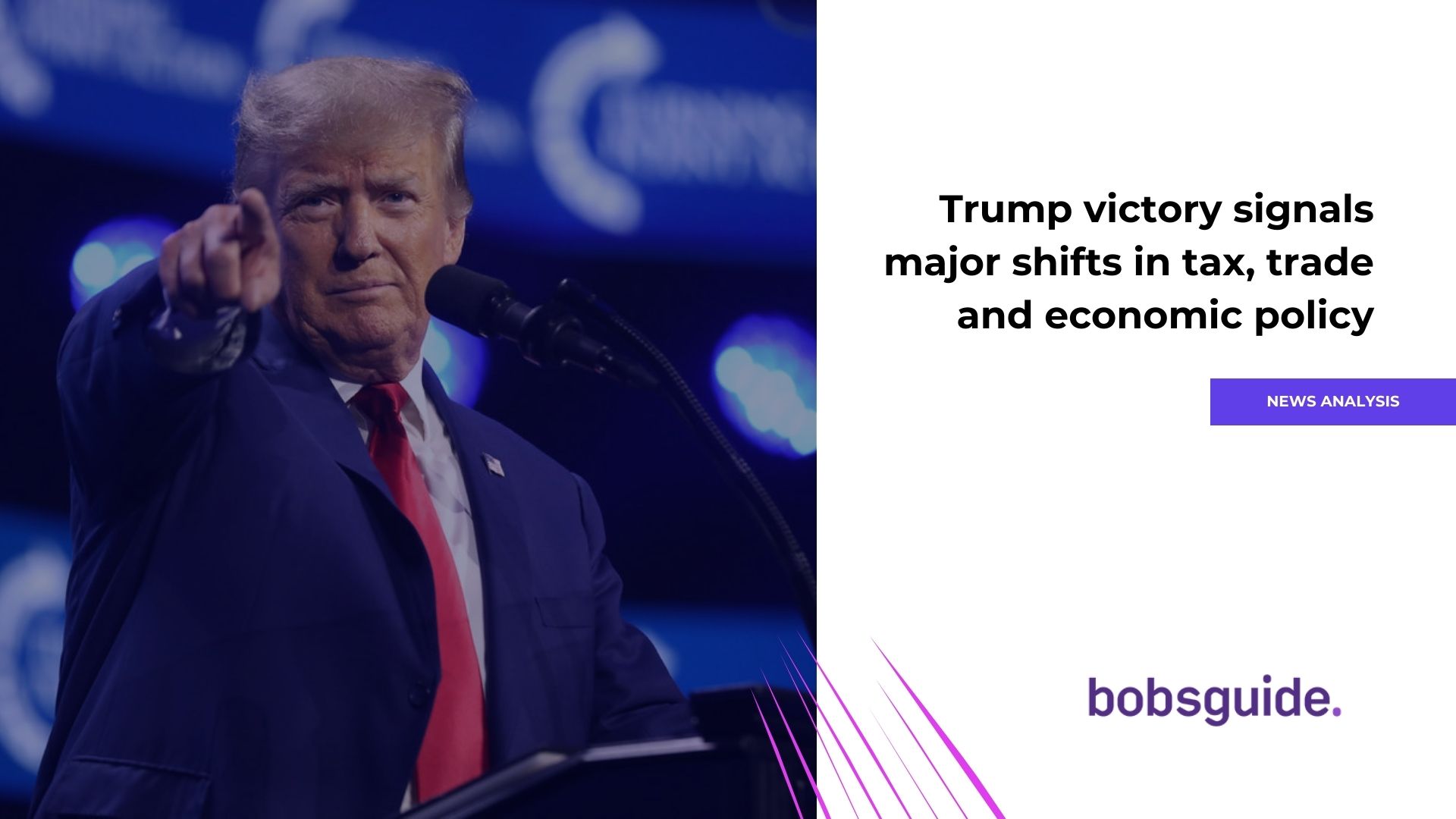Trump victory signals major shifts in tax, trade and economic policy
Donald Trump’s return to the White House heralds major shifts in U.S. economic policy, with expected changes in corporate taxes, trade, and fiscal strategy poised to impact global markets.
-
Rachael Kennedy
- November 7, 2024
- 4 minutes

Donald Trump’s comeback victory in Tuesday’s presidential election paves the way for sweeping changes to U.S. economic policy, with substantial implications for corporate taxation, international trade, and financial markets.
Trump secured 279 electoral votes to Kamala Harris’s 223, marking a historic return to the White House. Winning 71,579,698 votes, representing 50.9% of the popular vote, Trump outpaced Harris, who received 66,656,079 votes, or 47.4% of the total.
The victory, delivered through wins in crucial battleground states, demonstrated Trump’s increased electoral strength as he expanded his margins across much of America. Addressing his supporters at his election night rally in West Palm Beach, Florida, Trump claimed an “unprecedented and powerful mandate” and promised to usher in “the golden age of America.”
The Republican success extended beyond the presidency, with the party regaining control of the Senate after four years under Democratic leadership. However, the final composition of the House of Representatives remained undetermined as of early Wednesday, with some results expected to take days or even weeks to finalise.
Exit polls, still under review, suggested Trump had made significant inroads into traditional Democratic strongholds, increasing his support among young, Hispanic, and Black voters. His campaign successfully mobilised strong turnout among his rural base while simultaneously reducing Democratic margins in urban areas.
The election outcome cements a fundamental shift in American politics towards conservative populism, a movement sparked by Trump’s 2016 victory and seemingly halted by his 2020 defeat. His return to power comes eight years after his upset win over Hillary Clinton and four years after Joe Biden removed him from office.
What does this mean for markets?
Central to Trump’s economic agenda is a proposal to reduce the corporate tax rate from 21% to 15%, along with an extension of business investment provisions from his 2017 Tax Cuts and Jobs Act (TCJA). These provisions would restore and make permanent the ability for companies to immediately deduct equipment investments and research expenses from taxable income.
However, the Penn Wharton Budget Model projects that these changes would increase primary deficits by $5.8 trillion over the next decade on a conventional basis, or $4.1 trillion when accounting for economic feedback effects. While GDP may increase early in the decade, the analysis suggests it could fall by 0.4% by 2034 and 2.1% within 30 years.
Trade policy overhaul
Trump’s trade policies signify a marked departure from decades of U.S. economic tradition. The president-elect has pledged to impose a blanket tariff of 10% to 20% on all imports, with targeted tariffs of up to 60% on Chinese goods. He has also indicated intentions to renegotiate the USMCA trade agreement with Mexico and Canada.
The economic consequences could be substantial. Investment bank UBS estimates that a 10% universal tariff could prompt a 10% contraction in the stock market. The Peterson Institute for International Economics warns that Trump’s policies could raise inflation rates to between 6% and 9.3% by 2026, compared to a baseline estimate of 1.9% without them.
These policies could significantly impact corporate operations and costs. The Peterson Institute projects that the average American household could face annual cost increases of between $2,600 and $7,600, highlighting potential price pressures throughout the supply chain. Companies heavily reliant on international supply chains may face particular challenges in adapting to the new trade landscape.
Implementation timeline
While Trump has outlined ambitious plans, many of his proposals would require congressional approval. With the balance of power in the House of Representatives still uncertain, the timeline and scope of implementation remain unclear. However, Trump will have the backing of a Republican-controlled Senate, easing the path for his political appointees and judicial picks.
The broader fiscal impact of Trump’s proposals extends beyond corporate taxation. His plans include eliminating taxes on Social Security benefits, tips, and overtime pay, while preserving Social Security and Medicare benefits. The Committee for a Responsible Federal Budget cautions that these policies could hasten Social Security’s path to insolvency, potentially depleting the trust funds by 2031 unless Congress intervenes.
Trump has surrounded himself with a team of potential advisors, including billionaire Elon Musk, who has agreed to lead a new efficiency commission, alongside other figures instrumental in his electoral coalition. Their influence on economic policy implementation remains to be seen.
As markets digest the implications of Trump’s victory, focus now shifts to the transition period and the incoming administration’s early priorities. Trump has promised that while his second term might “be a little nasty at times, especially at the beginning,” the final outcomes will benefit the country.
This article was originally published on Bobsguide’s sister publication, The Global Treasurer.


 Bobsguide is a
Bobsguide is a